Birds come in all shapes and sizes. Some live by the coast, others live in forested areas. They also come in a host of colors with some being pink or having some pink coloration, whether on the breast, wings, beak, or head.
Continue reading below to identify the types of pink birds you may encounter along with where you can find them.
Table of Contents
1. House Finch
The House Finch (Haemorhous mexicanus) is native to western North America. It has been introduced to the eastern regions and Hawaii.
This medium-sized bird can grow to fifteen centimeters in length and weigh up to twenty-seven grams.
As adults, their tails are square-tipped and brown with dull brown down their backs with shades of gray. Their breast and belly can be pink. Males have pink on their shoulders, heads, and neck. The males’ coloration varies depending on the season and is believed to come from the berries that they consume.
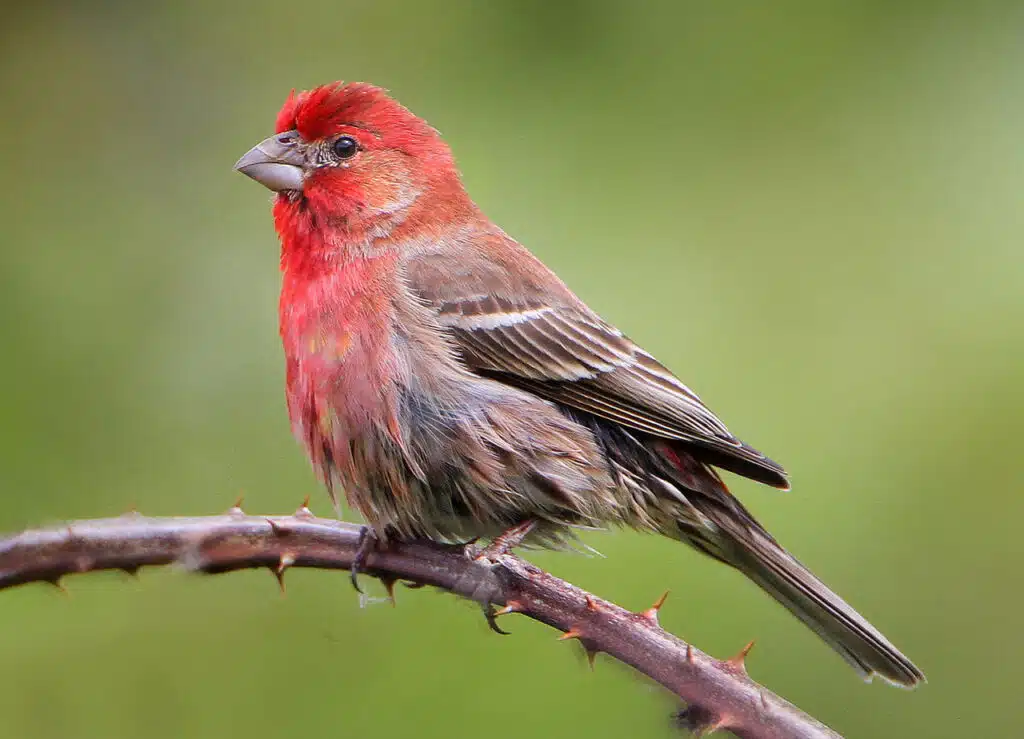
Some of the birds in the north and east migrate south. They are commonly seen in suburban areas and semi-open areas.
There are approximately 1.7 billion house finches throughout North America today.
You can see this bird from Nova Scotia to the Yukon, across Florida and California, along with Mexico and Central America.
2. Anna’s Hummingbird
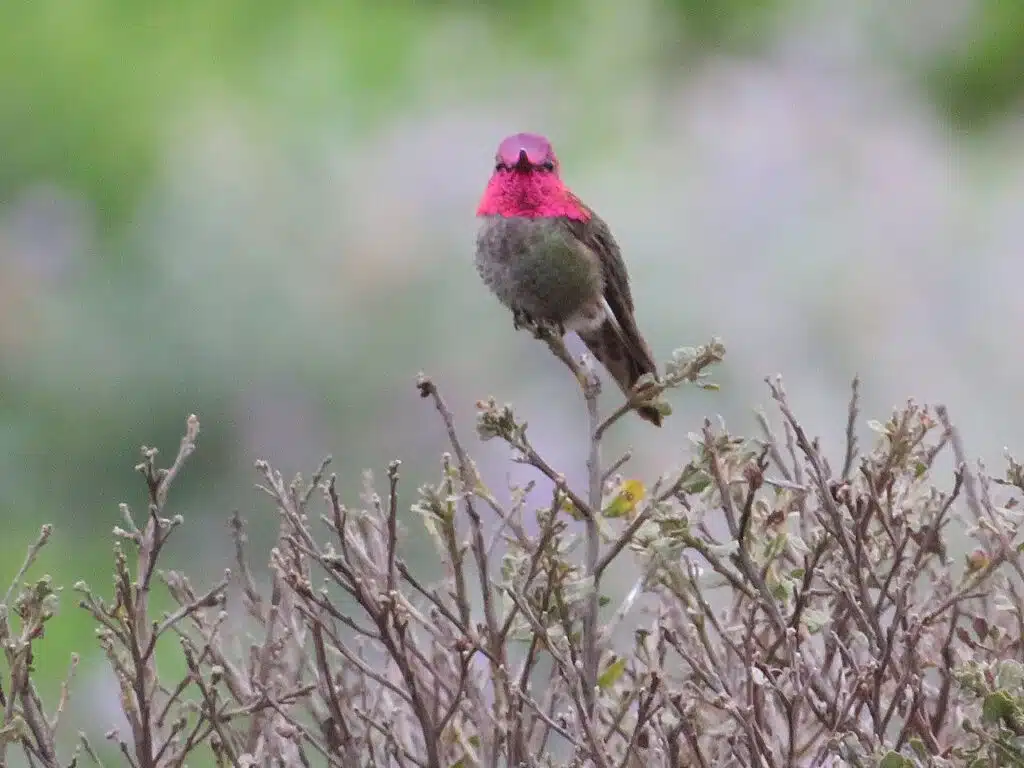
This (Calypte anna) is a medium-sized bird native to western coastal areas in North America. This bird grows to just under eleven centimeters in length with a twelve-centimeter wingspan. Their backs are bronze-green with a pale gray belly and chest with green flanks.
Anne’s hummingbirds have long and straight beaks with the adult male being a pink to red crown and a forked tail. The females are smaller and less colorful than the males. The males are the only hummingbird in America with a pink to red colored crown. Juveniles and females have dull green crowns.
This bird can be seen along the western coast of North America from Baja California to southern Canada. It is also seen in Arizona, southern Nevada, western Texas, and southeastern Utah.
While they are not migratory birds, some are known to move outside their range, which includes New York, Florida, Newfoundland, Louisiana, and Alaska.
3. Roseate Spoonbill
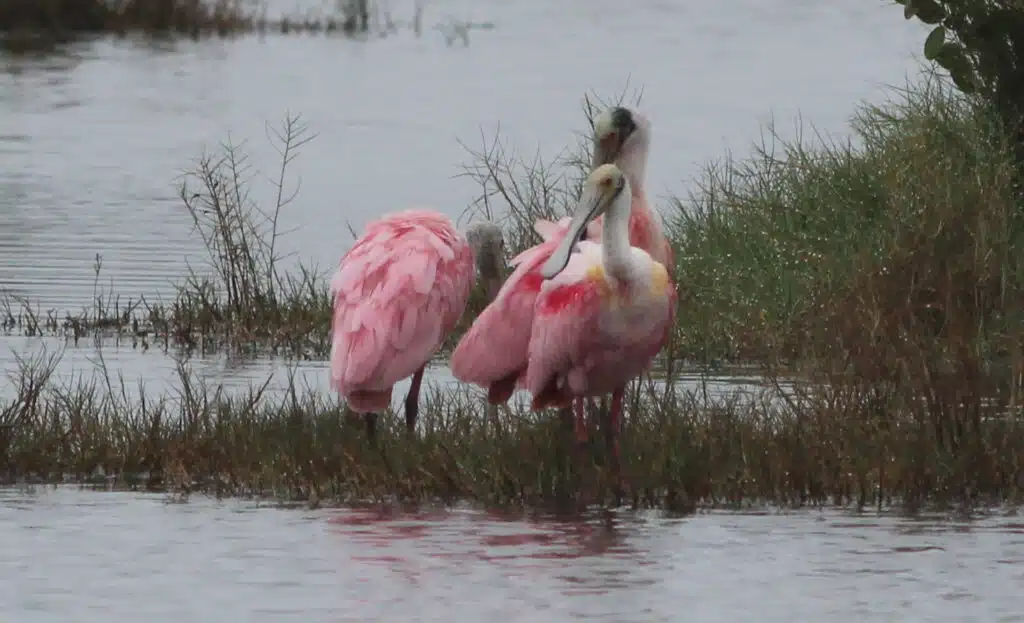
Roseate Spoonbills (Platalea ajaja) are wading birds of the ibis family. It breeds in North America and South America. They have pink coloration that is derived from their diet. They neared extinction in the eighteenth and nineteenth centuries due to plume hunting.
This bird grows to eighty-six centimeters in length with a 133-centimeter wingspan. They can weigh up to 1.8 kilograms. The head is green when breeding with a white neck and back. The breast has pink feathers in the center during the breeding season. They have a gray beak with no significant difference between males and females.
Their pink coloration can vary from bright magenta to pale pink, depending on the bird’s age, whether they are breeding, and their location. They fly with outstretched necks.
You will find this bird in Florida, Louisiana, and Texas. It also occurs in South America, the Caribbean, Central America, the Gulf Coast of the United States, and Mexico. In 2021, there were sightings in Washington DC, upstate New York, and New Hampshire.
4. Purple Finch
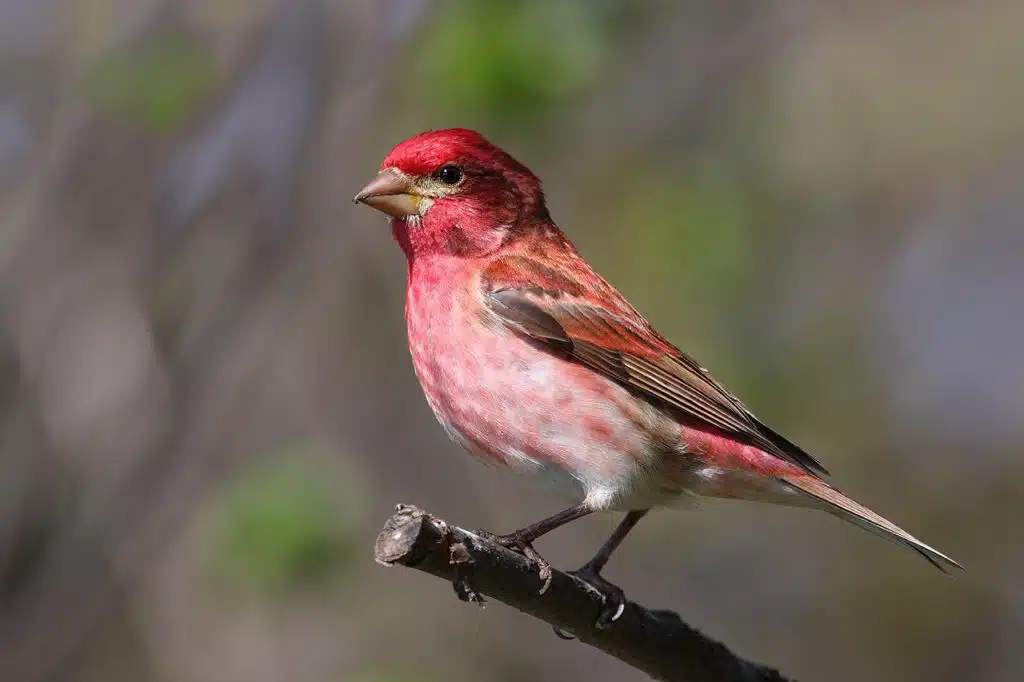
The Purple Finch (Haemorhous purpureus) has a brown forked tail and brown wings. Males can have bright pink breasts, rumps, back, and heads. Females are light brown with white bellies, and a white line on the face, just above the eyes.
This bird can grow to sixteen centimeters in length with a twenty-six centimeter wingspan, weighing only thirty-two grams. Their populations have declined in the East as a result of the house finch. When they come in contact with each other, the house finch out-competes the purple finch, leaving it displaced from some habitats.
They prefer coniferous and mixed forests in the northwestern United States and Canada. On the US Pacific Coast, they can be found in wooded areas. The purple finches in northern Canada migrate to the southern United States during the winter months.
5. Cassin’s Finch
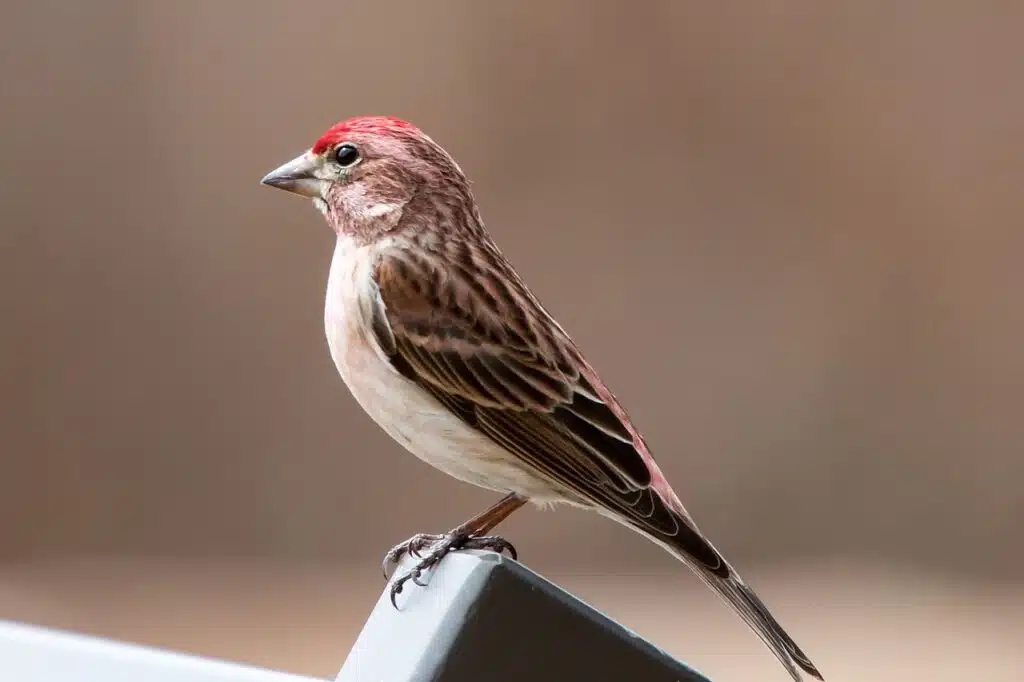
Cassin’s Finch (Haemorhous cassinii) is a medium-sized bird, growing to sixteen centimeters in body length with a twenty-seven-centimeter wingspan. As adults, they have brown forked tails and brown wings. Their beaks are longer than the purple finch, described above.
The males are pink on their breasts, rump, back, and head. Under the tail is streaked in pink. Females are light brown with brown streaks. They are often seen foraging in trees and in ground vegetation. Their diet comprises seeds, berries, and some insects.
They breed in coniferous forests in the mountain areas in western North America, including northern New Mexico, southern California, Baja California, and Arizona. The birds in the northernmost areas migrate south during the winter months.
6. Pine Grosbeak
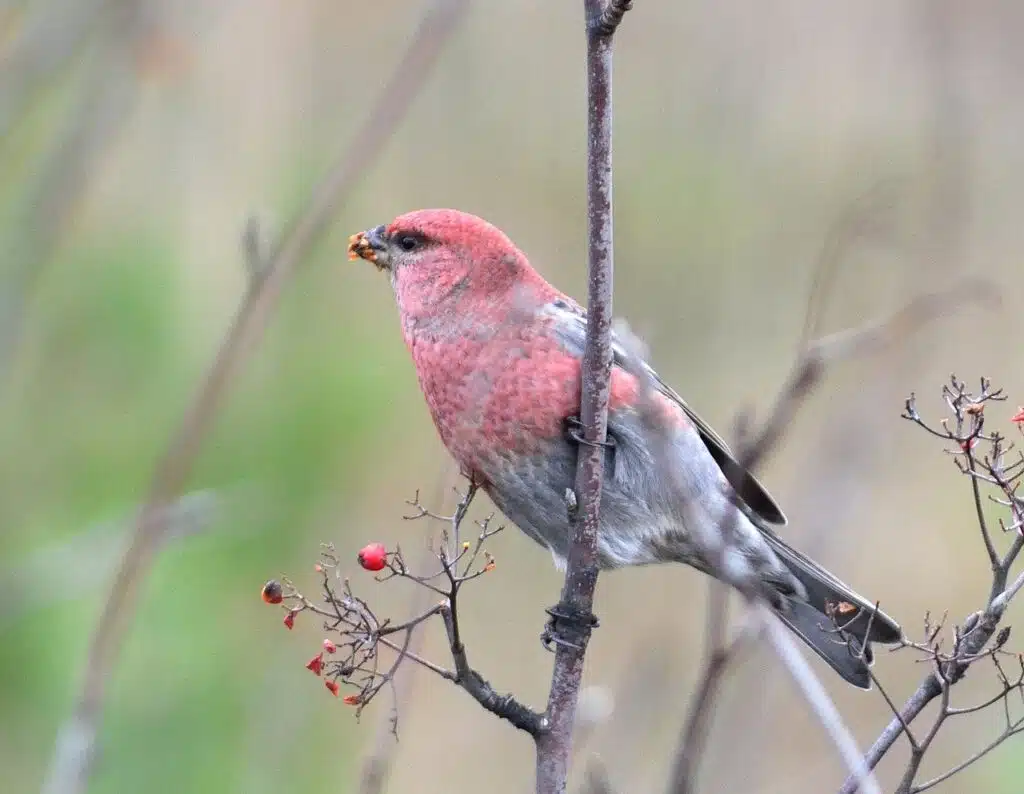
The Pine Grosbeak (Pinicola enucleator) is a large bird belonging to the finch family. You will find it in coniferous forests in Alaska, the western United States, and Canada. They favor small fruits.
These birds can grow to more than twenty-five centimeters in length and weigh up to seventy-eight grams. Their black tails are long and forked. The wings are black with white bars. They have large beaks.
The males have rose-pink backs, rumps, and heads. Females are olive-yellow on the rump and head. This bird breeds in the forest of northern Eurasia and North America. They remain residents near their breeding grounds, migrating short distances in southern areas. They can also be seen in northern New England and the northern Great Lakes areas.
7. Lewis’s Woodpecker
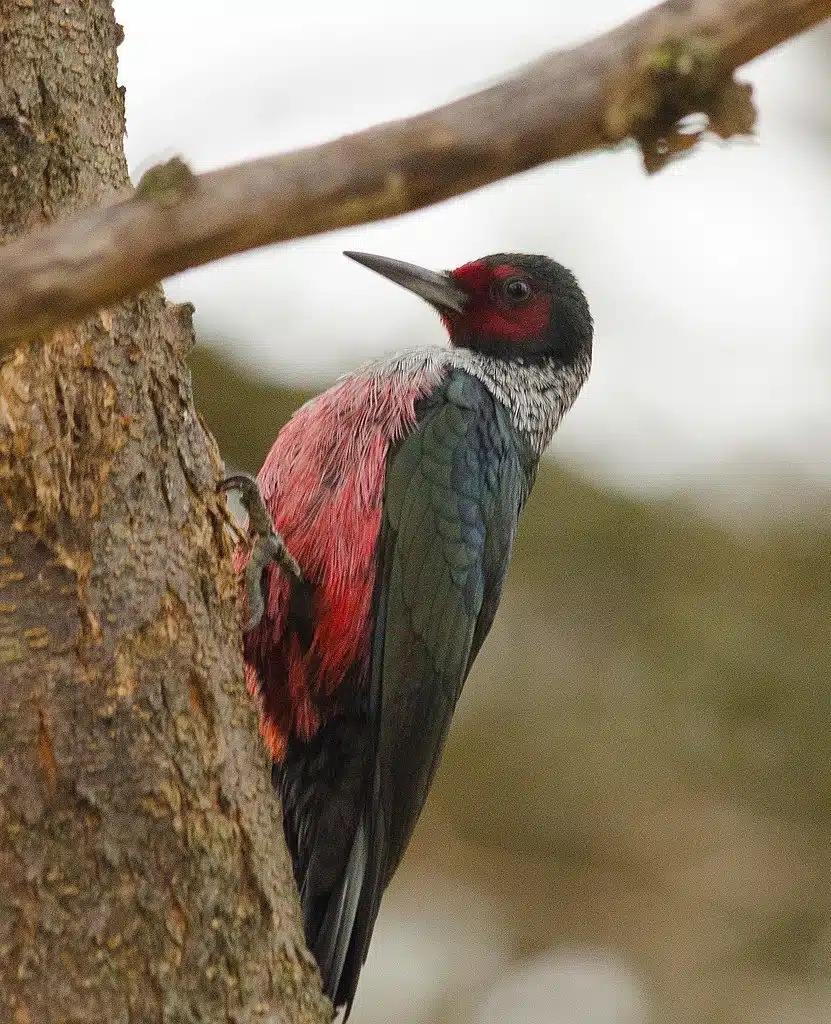
Lewis’s Woodpecker (Melanerpes lewis) is one of the largest American woodpeckers, growing to more than twenty-eight centimeters in length. They are pink-breasted with back-green overall color and a black rump.
There is a gray collar on the upper breast with a pink belly. Their faces are red. They fly slowly, flapping similarly to crows. These birds prefer open pine woodlands and areas with scattered trees.
They can be seen in the western and central United States, spending winter in the south. Some spend winter in Mexico and move to Canada for the summer. They have been seen in South Dakota, Illinois, Wisconsin, Minnesota, and Michigan.
8. White-winged Crossbill
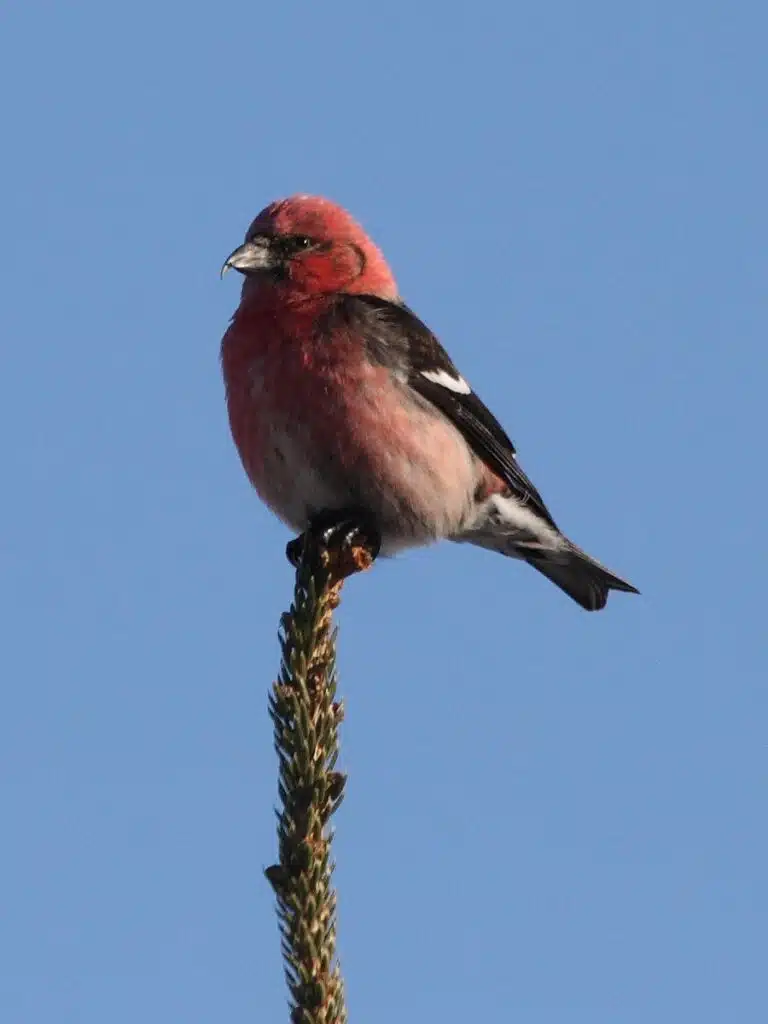
The White-winged Crossbill (Loxia leucoptera) can grow to seventeen centimeters in length with a twenty-nine-centimeter wingspan. They feed primarily on conifer cones with a beak adapted to help extract the seeds from the cone.
The males are pink or red, whereas the females are yellow or green. In the Palearctic range, they are smaller. The main plumage is the white wing bards. Males tend to be brighter than females.
They breed in the coniferous forests of Alaska and the northernmost United States, across northeast Europe. They nest in conifers and can lay up to five eggs each breeding season.
9. Common Waxbill
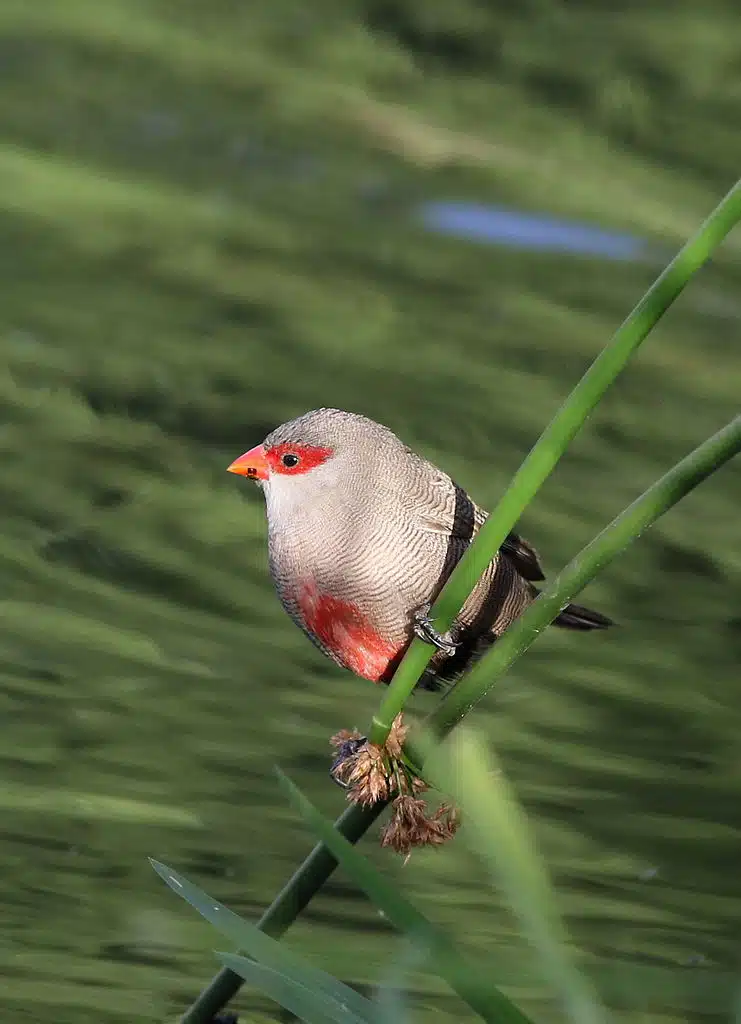
The Common Waxbill (Estrilda astrild) is also known as St Helena’s waxbill. It is a small bird that belongs to the finch family and is native to sub-Saharan Africa. It has been introduced to other regions. They are very popular as pets.
This small bird has rounded wings and a long tail. They have a bright red beak with gray-brown plumage with dark brown bars. There is a red stripe that runs through the eye with a white throat and cheeks. There is a pink tinge to the belly and a red stripe down the center of the belly.
There are approximately seventeen subspecies of the common waxbill distributed throughout Africa, south of the Sahara Desert. They can be found in East, Central, and Southern Africa. Over the years they have escaped captivity or been deliberately released.
They have been introduced to Saint Helena, Ascension Island, Cape Verde Islands, Mauritius, Reunion, Seychelles, and Amsterdam. They are also found in Trinidad, Bermuda, and several areas in Brazil.
10. American Flamingo
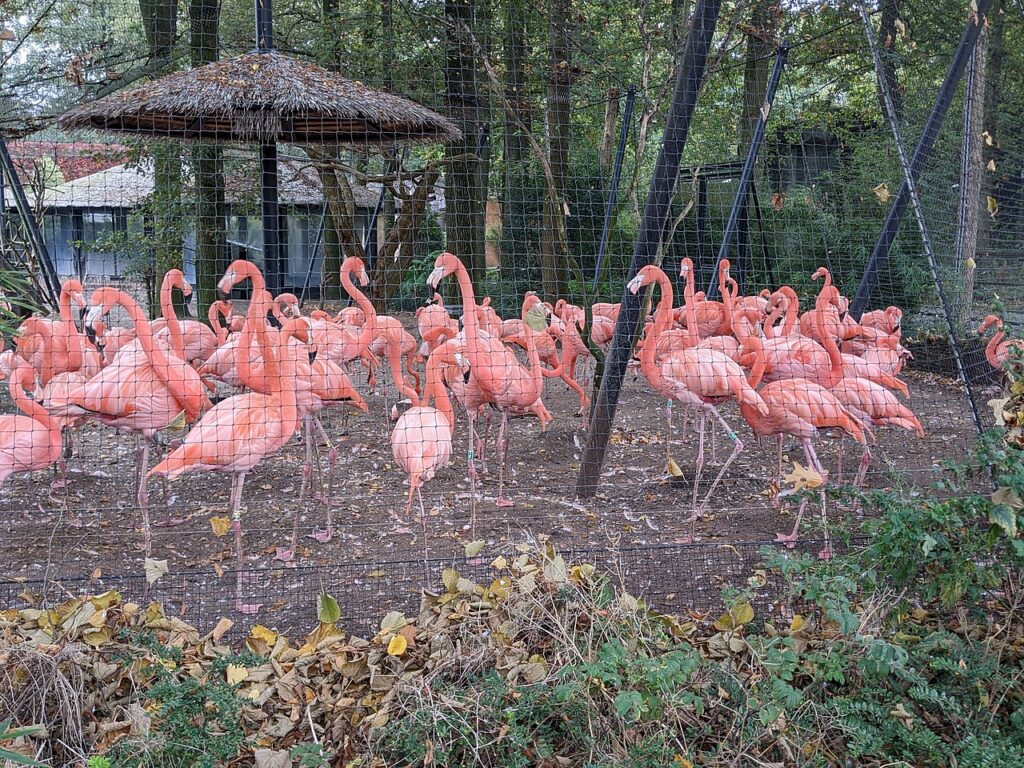
The American Flamingo (Phoenicopterus ruber) is a large bird native to the Neotropics. It is a large wading bird with pink plumage. The American flamingo is slightly smaller than the greater flamingo, growing to 145 centimeters in length.
Males can weigh more than 2.8 kilograms, while females weigh an average of 2.2 kilograms. Their plumage is pink with red wing coverts and black secondary flight feathers. The beak is white and pink and the legs are pink.
They breed in South America in the Galapagos Islands, West Indies, Tobago, Jamaica, Dominican Republic, and Haiti. They are also seen in the extreme south of Florida in the United States. They prefer saline lagoons, brackish coastal lakes, inland lakes, and mudflats.
They are often seen in South Florida and the Florida Keys. These birds do not migrate and are permanent residents. This is the northernmost extent of their distribution.
11. Black Rosy-Finch
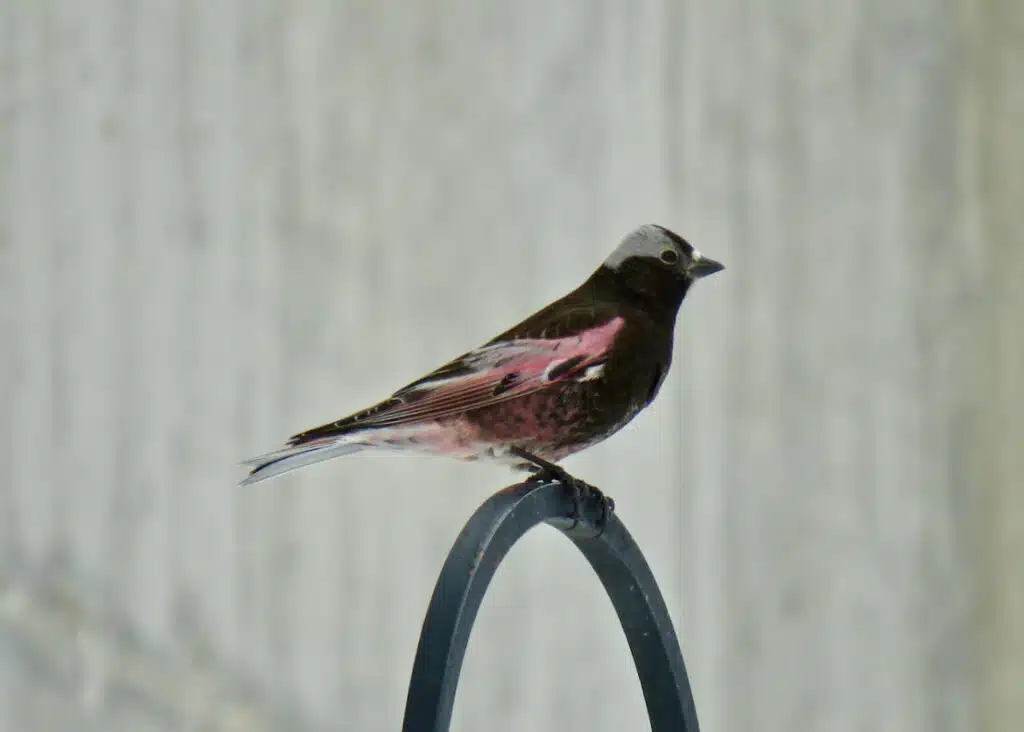
The Black Rosy-Finch (Leucosticte atrata) is black on the back, breast, and head with pink on the belly, wings, and rump. They have a gray patch on the back of their heads. The short legs are black. They have short-forked tails.
They prefer mountain areas, just above the tree line. They are often seen on cliffs and among alpine rocks. They are common in the southern and eastern areas of North America.
12. Common Redpoll
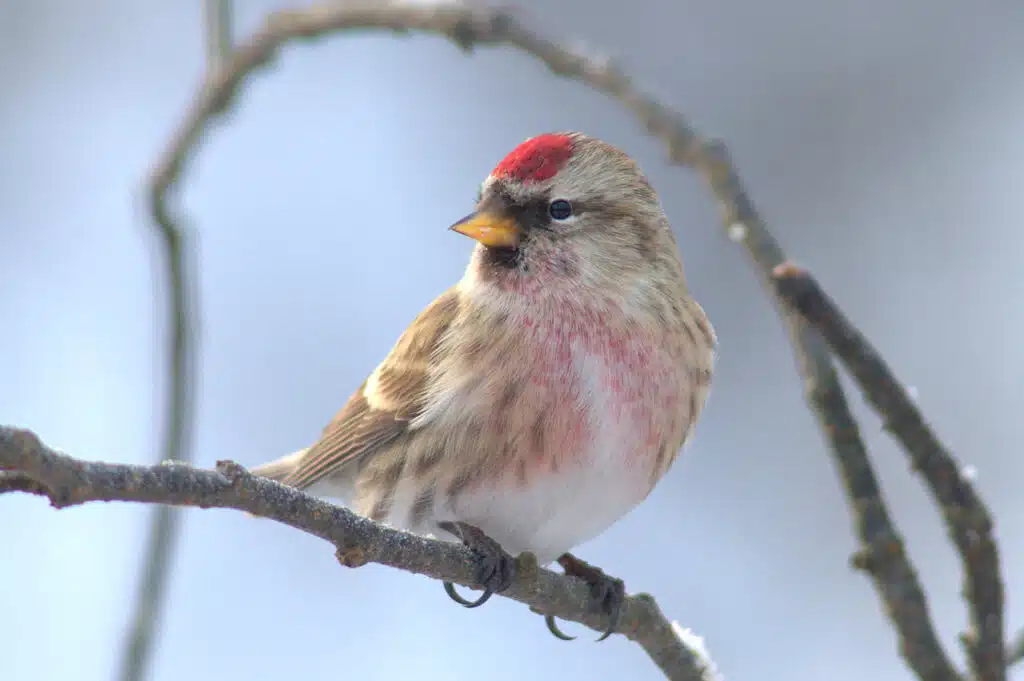
The Common Redpoll (Acanthis flammea) is a small brown-gray finch that has dark streaks and a bright pink patch on the forehead. These birds have a black bib and two pale stripes on their wings.
The males have pink on their breasts. They grow to fourteen centimeters in length and can weigh up to sixteen grams. The legs are brown and the beach is dark with a yellow tip. They build their nests low down in a bush or tree. The female lays up to seven speckled eggs that take approximately eleven days to hatch.
The common redpoll can be found through Asia and northern Europe to northern North America. They tend to move southward in the autumn and back to the north in March and April. They are often seen in forests where they feed on seeds.
13. Brown-capped Rosy-Finch
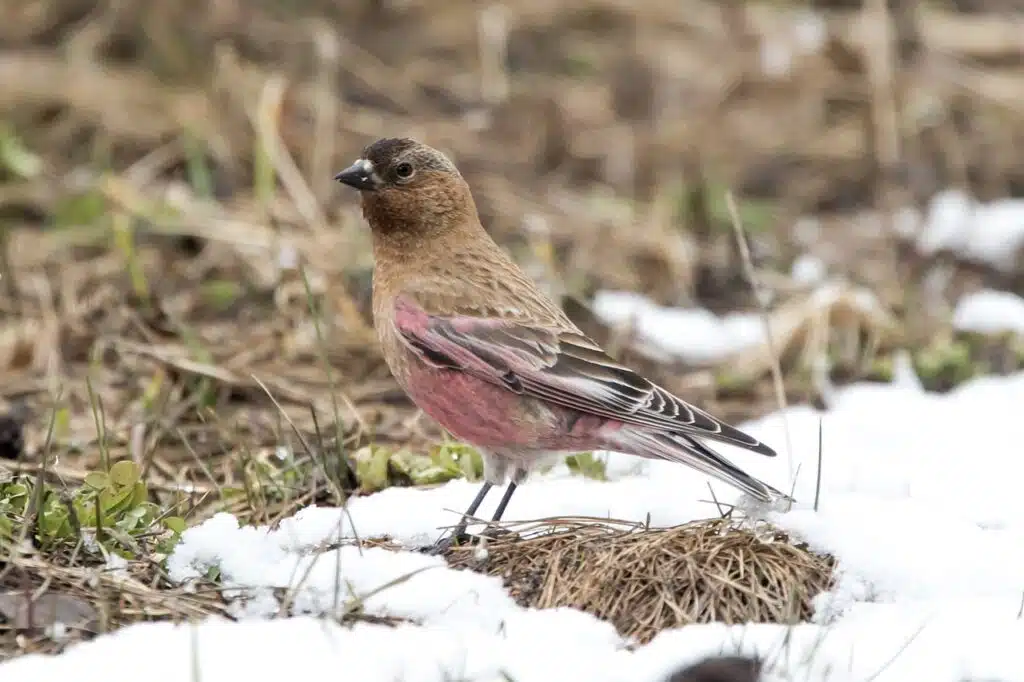
The Brown-capped Rosy-Finch (Leucosticte australis) is a medium-sized bird in the finch family, endemic to North America. The adults have brown heads and back with pink on the belly, wings, and rump. They have black foreheads and legs with forked tails.
They breed in the mountain peaks in central rocky Mountains, building a cup nest in a cliff cavity. Sometimes they use abandoned swallow nests. They migrate short distances to lower elevations during the winter months. The brown-capped rosy finch forage in the ground and is known to catch insects in flight. Their primary diet is seeds and insects.
This bird has a restricted range in Colorado and northern New Mexico. They are easy to identify with the pink highlights on the belly and wings.
14. Gray-crowned Rosy-Finch
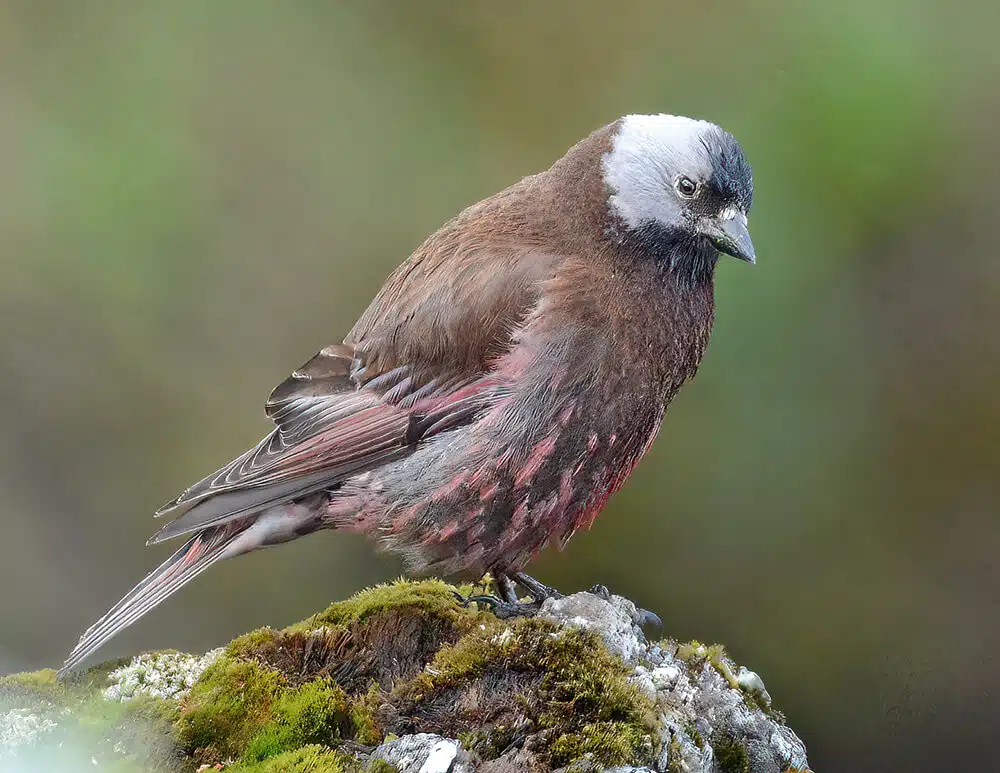
This is a medium-large finch with a long tail and wings. The adults are brown on their backs and breasts. The rest of the body, including under the wings is pink. They have a black forehead and throat with gray on the back of their heads. They grow to sixteen centimeters in length with a thirty-three-centimeter wingspan. They can weigh up to sixty grams.
It has a wide range with large numbers found in Alaska, western Canada, and the United States. They are permanent residents in the Aleutian Islands with small numbers in maintain South-Central Alaska. They are also found in the Canadian and American Rockies, migrating south to the western United States.
15. Eurasian Bullfinch
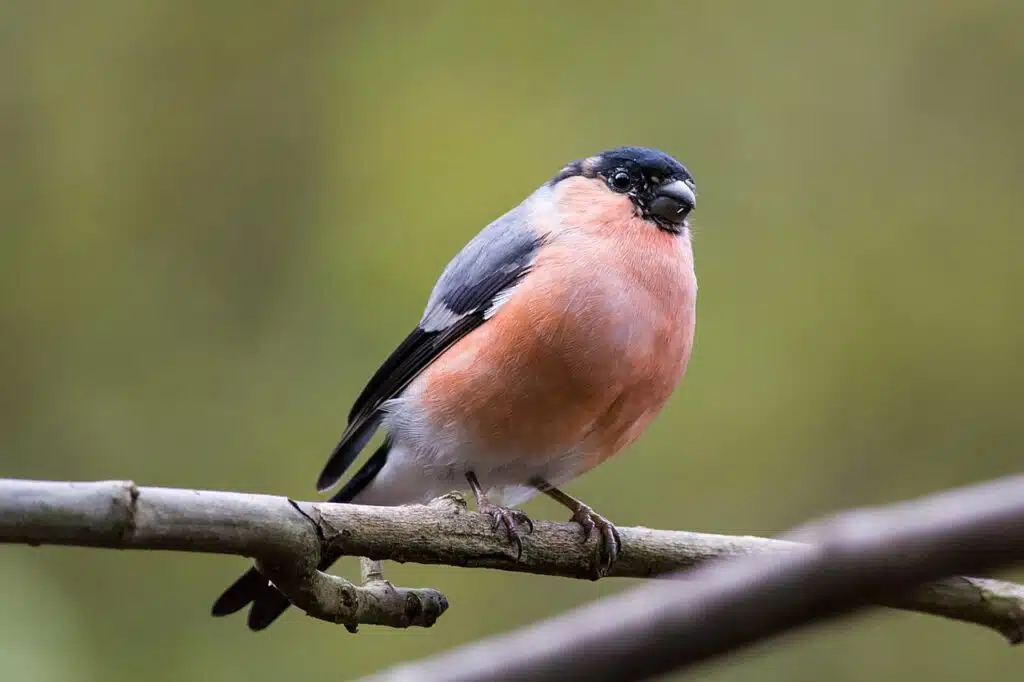
This is a bulky bird that is gray with black flight feathers and beaks. The rump and wing bars are white. Adult males have pink bellies whereas females and juveniles have gray bellies. They grow to around fifteen centimeters in length.
They breed throughout Asia and Europe with many birds moving south during winter. They can be found in mixed woodlands, parklands, and gardens.
16. Galah
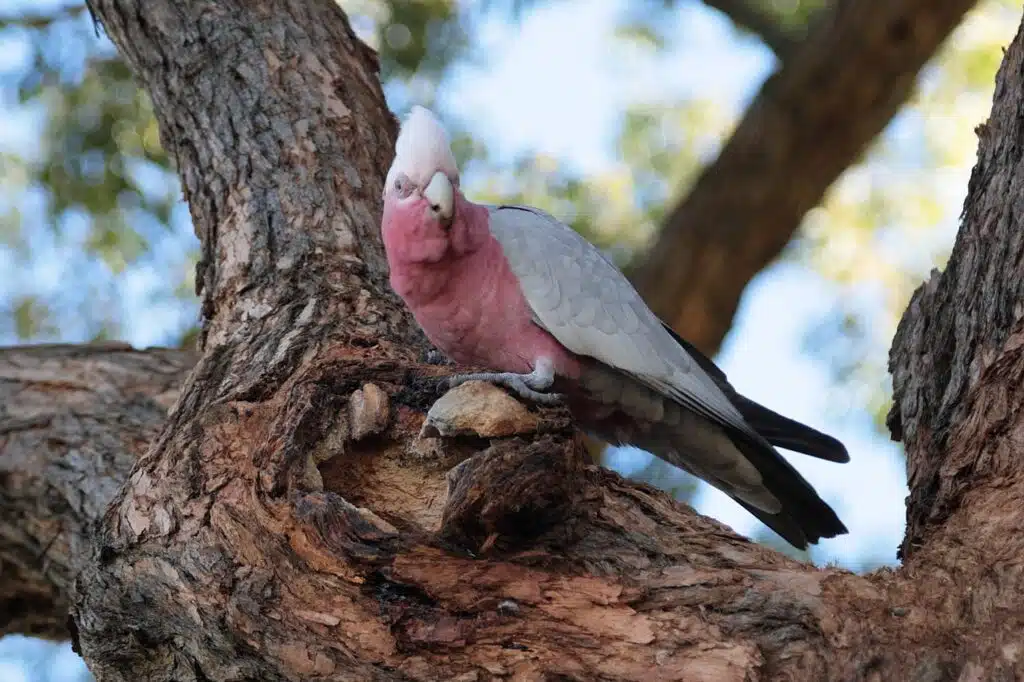
The Galah (Eolophus roseicapilla) is better known as the pink and gray cockatoo or the rose-breasted cockatoo. It is found in Australia and is the most common cockatoo seen in their range. They have pink and gray plumage. They are seen in the wild and urban areas.
This bird grows to thirty-five centimeters in length and is gray to pale silver on the back and rump with a pink breast and face. The beak is bone-colored and the legs are gray. The males can have dark brown irises, whereas the females have red or light brown irises. Juveniles are dull in color when compared to adults.
The galah can be seen throughout Australia, except for the dry areas and far north of Cape York Peninsula. They have also been introduced to Tasmania. They are common visitors in metropolitan areas including Melbourne, Perth, and Adelaide. They are mostly seen in inland areas, though they are quickly colonizing the coastal areas.
17. Common Rosefinch
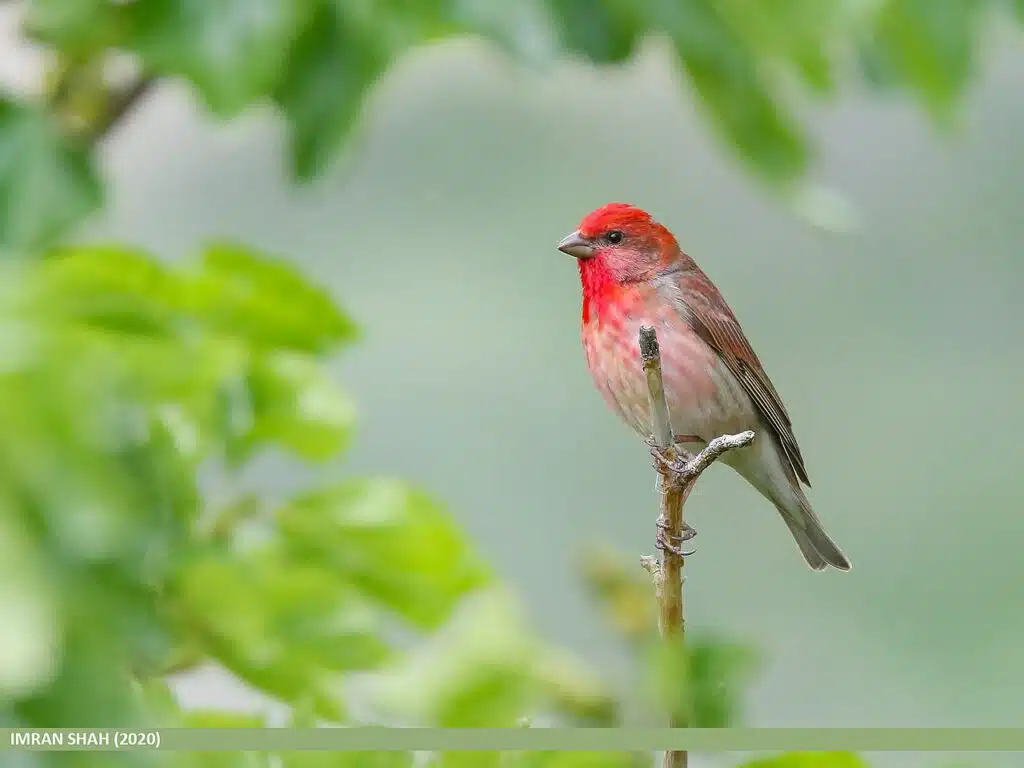
The Common Rosefinch (Carpodacus erythrinus) grows to fifteen centimeters in length. It is a stout bird with mature males having a bright rose-pink head, breast, and rump. The wings are dark brown with two bars. They have white bellies.
Females and juveniles are dull in color with yellow-brown backs and gray on their heads. They molt in winter from September to November. Males’ pink coloration is subdued after molting and brightens over time.
These birds can be found throughout Europe including England and Portugal. They are also found in Sweden, Siberia, Afghanistan, and the western Himalayas. They prefer wooded edges, forest edges, gardens, wetlands, oak woods, orchards, and thickets.
18. Long-tailed Rosefinch
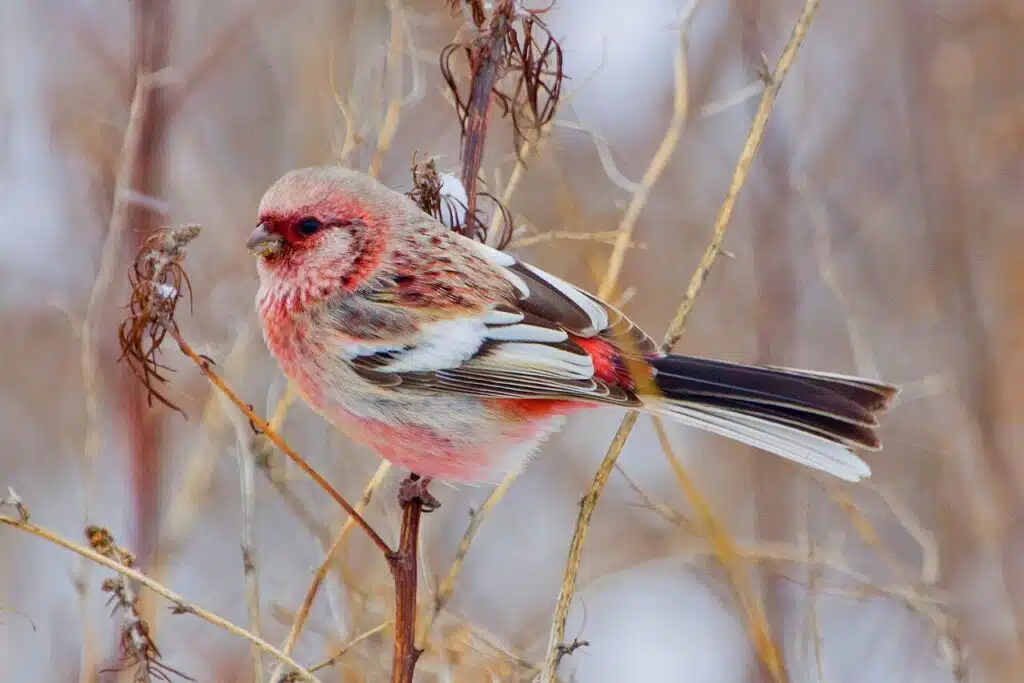
The Long-tailed Rosefinch (Carpodacus sibiricus) is a common pet bird with escapes being the main reason for its introduction to Europe. This is a plump finch with males being pink with two white wing bars and gray highlights. Females and juveniles are dull in comparison with gray bodies and burned-orange rumps and heads. The beaks are rounded and stubby.
They are common in North and South Korea, Russia, Japan, and Kazakhstan where they can be found in shrublands, grasslands, temperature forests, and subtropical shrublands.
19. Chilean Flamingo
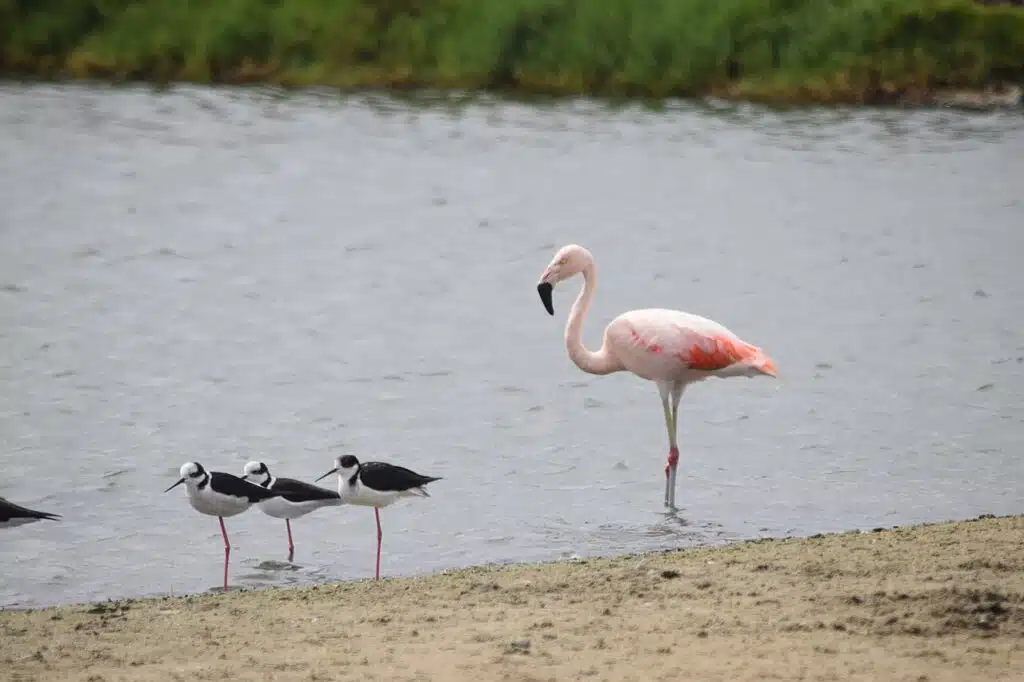
Chilean Flamingos (Phoenicopterus chilensis) are large birds that grow to one hundred and thirty centimeters in length. They are similar to the American flamingo and are listed as Near Threatened by the IUCN. They are restricted to soda lakes and salt lagoons.
They have pink plumage with gray legs. The legs have pink joints. There is black around the beak. Juveniles have no pink color and tend to be peach or gray. They are filter feeders and their beaks are equipped with comb-like structures so they can eat plankton and algae from the water.
These birds live in large flocks. During mating season the birds have numerous behaviors to attract mates, this includes swinging their heads from side to side. Males and females work together to build mud nests with both parents taking turns incubating the eggs.
A Chilean flamingo lived in the Tracy Aviary in Salt Lake City in 1988 and escaped. It became a legend in Salt Lake City and was named Pink Floyd. This bird would fly to Utah in winter and then north to Montana and Idaho in spring.
There has been a decline in numbers with numerous breeding programs being introduced in zoos. They breed in South America from Peru and Chile to Argentina and Ecuador. They have been introduced to the Netherlands.
20. Red-billed Firefinch
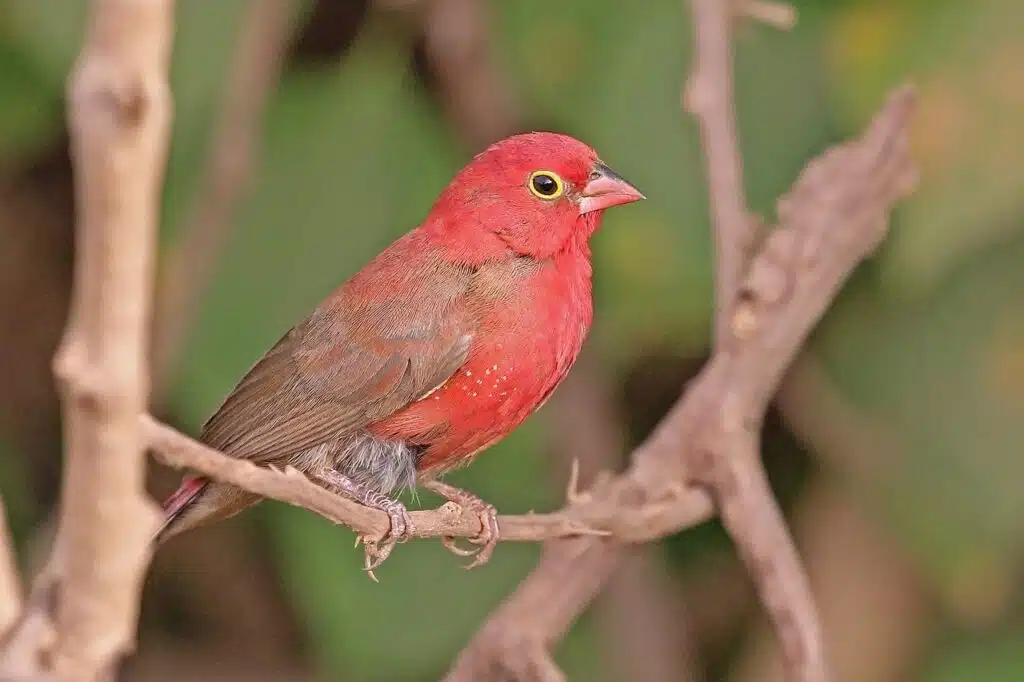
The Red-billed Firefinch (Lagonosticta senegala) is a small bird that feeds primarily on seeds. It is a breeding bird in Sub-Saharan Africa and was introduced to Egypt and southern Algeria. This bird grows to ten centimeters in length with adult males being pink except for their brown wings.
These birds have pink beaks with yellow eye rings. Females are brown on their bellies. There is a red patch just in front of both eyes. These birds are abundant in human habitats.
They are small gregarious birds that feed on seeds and grains in open grasslands. They nest in dome-shaped structures with a side entrance that is constructed in bushes, walls, or thatch. You will find them in Sub-Saharan Africa, southern Algeria, and Egypt.
21. Lesser Flamingo
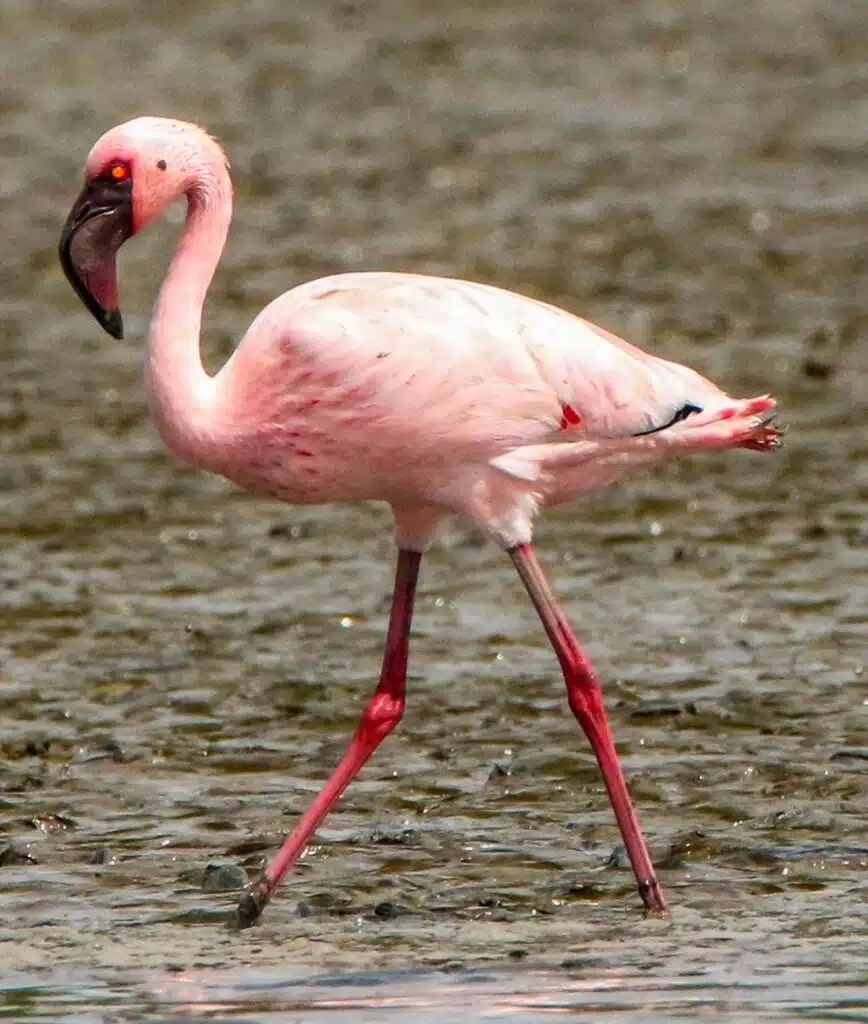
The Lesser Flamingo (Phoeniconaias minor) is from Sub-Saharan Africa and western India. They are a small species of flamingo that grows to around ninety centimeters, weighing just short of three kilograms.
Their plumage is pink and white. They are a large species with a population of around two million birds. They feed on algae and Spirulina. When they occur in large numbers near water it is an indication of alkaline water and is not suitable for irrigation.
Even though there are large numbers of these birds, they are classified as near threatened due to the low number of breeding sites and human activities. They are common in East African lakes.
22. Rosy Starling
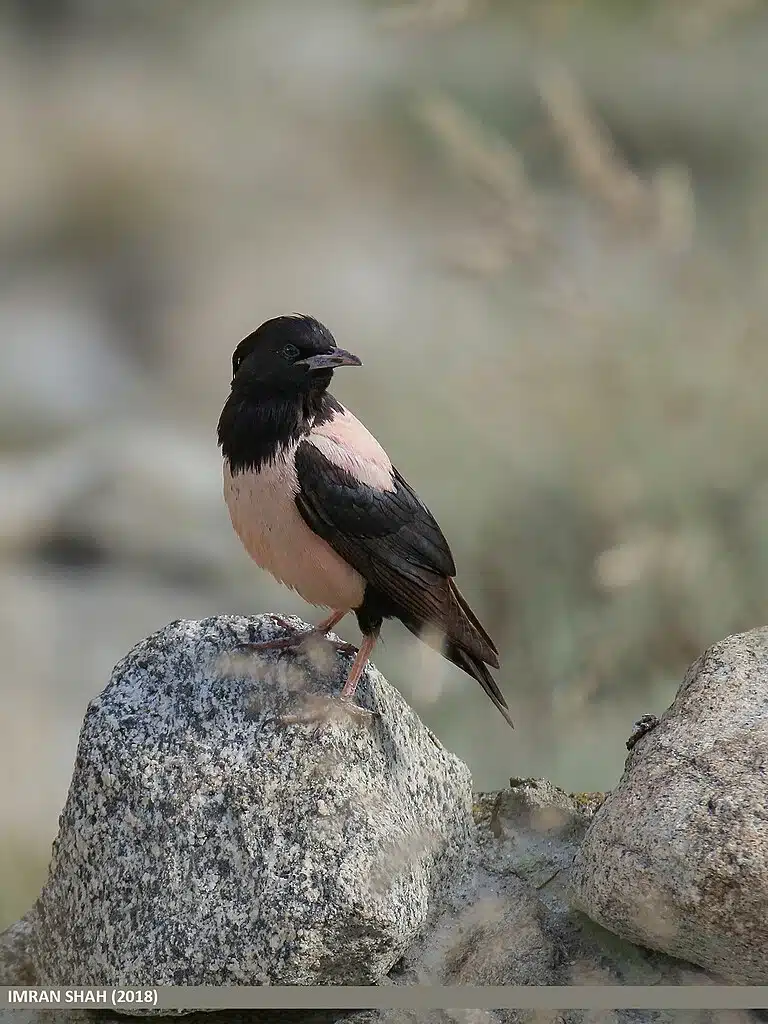
The Rosy Starling (Pastor roseus) is also known as the rose-colored pastor. They have pink bodies, pale orange legs and beaks, and glossy black tails, wings, and heads. During the breeding season, the males have elongated feathers on their heads, which form a crest.
As juveniles, they are lighter in color with short yellow beaks. Younger birds molt into dull versions of the adults in autumn, lacking the crest. They only acquire the adult plumage at one year of age in females and two years of age in males.
They breed in desert areas of Central Asia and Southeast Europe. They can be found in Mongolia, Kazakhstan, Tajikistan, southern Russia, Ukraine, Armenia, and Azerbaijan. In India, the rosy starling outnumbers the local starlings during the winter months.
They are known to move outside their range and have reached the United Kingdom, Ireland, and France.
23. Pink Robin
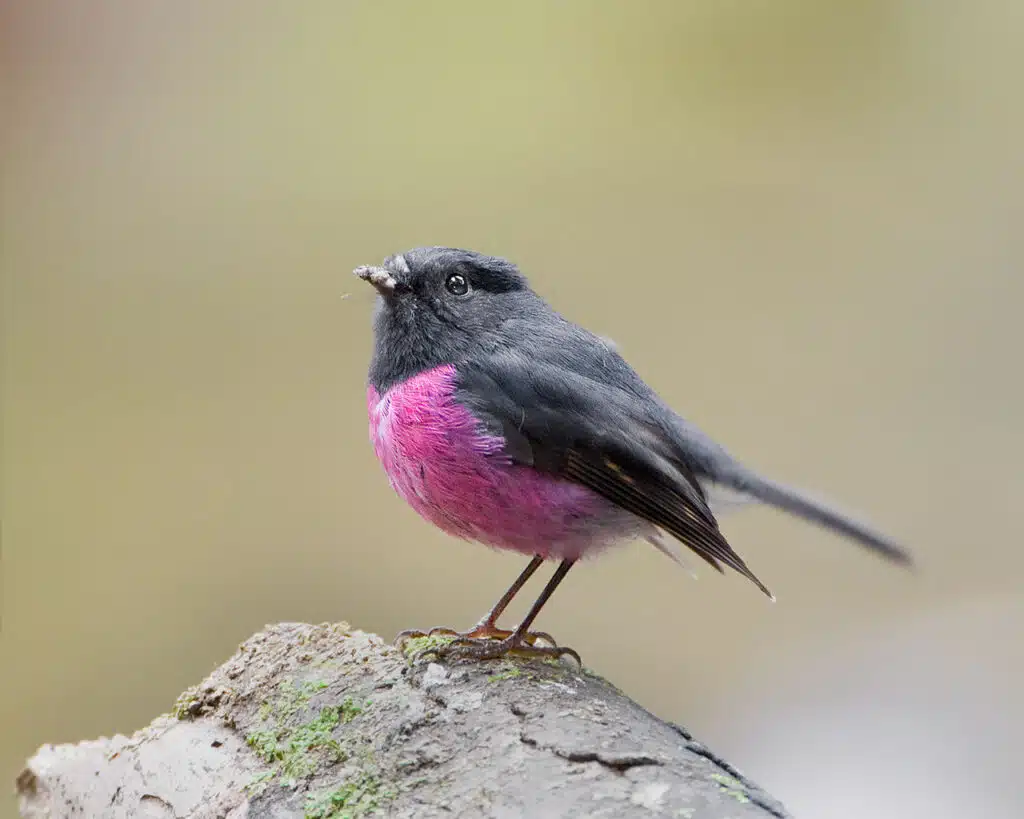
The Pink Robin (Petroica rodinogaster) is a small bird native to southwestern Australia where it is found in forest areas. They grow to 13.5 centimeters in length with small black beaks and dark brown eyes. Males have a white forehead spot and pink breasts with gray to black wings and tails.
Females are gray-brown with buff-colored wings and pink tinges on their bellies. The female’s beak and feet are black with dark brown eyes. They are common in the forest areas of southern Victoria and many areas within South Australia, New South Wales, and Tasmania.
24. Great Rosefinch
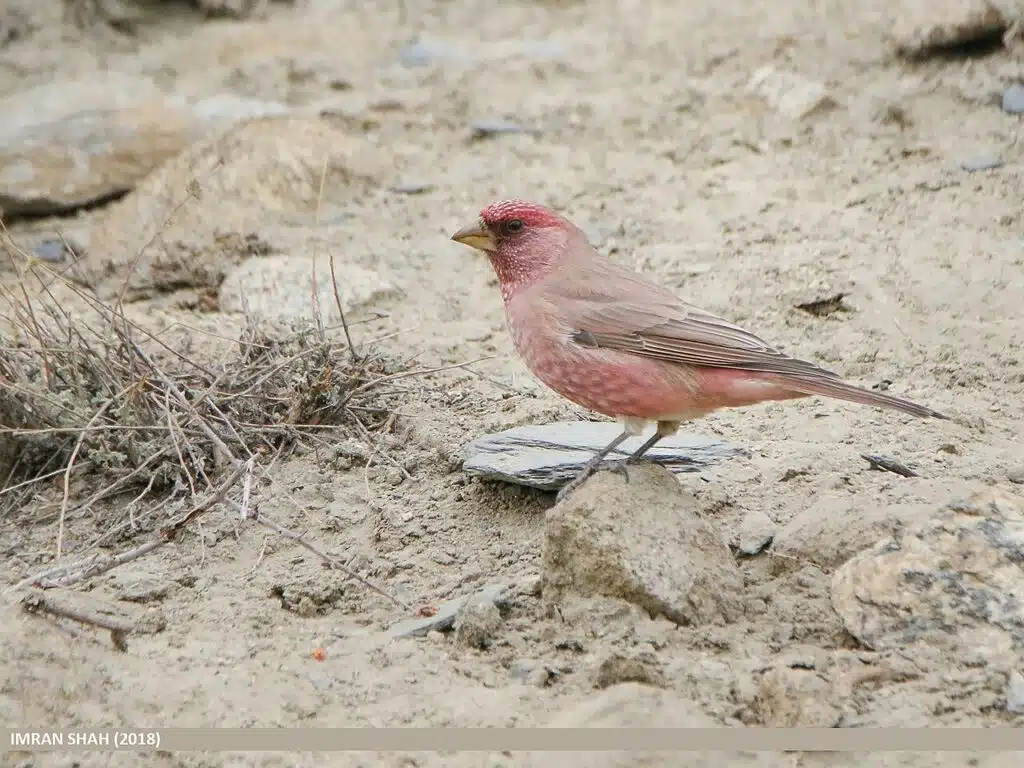
The Great Rosefinch (Carpodacus rubicilla) is a large rosefinch with males being bright pink with dark faces. Females are streaked in brown. They prefer sparsely vegetated areas in high elevations. They are often found in barren environments, open areas, and boulder fields.
This bird can be encountered in Georgia, China, Russia, Afghanistan, Iran, Mongolia, Pakistan, and Uzbekistan.
25. Rose Robin
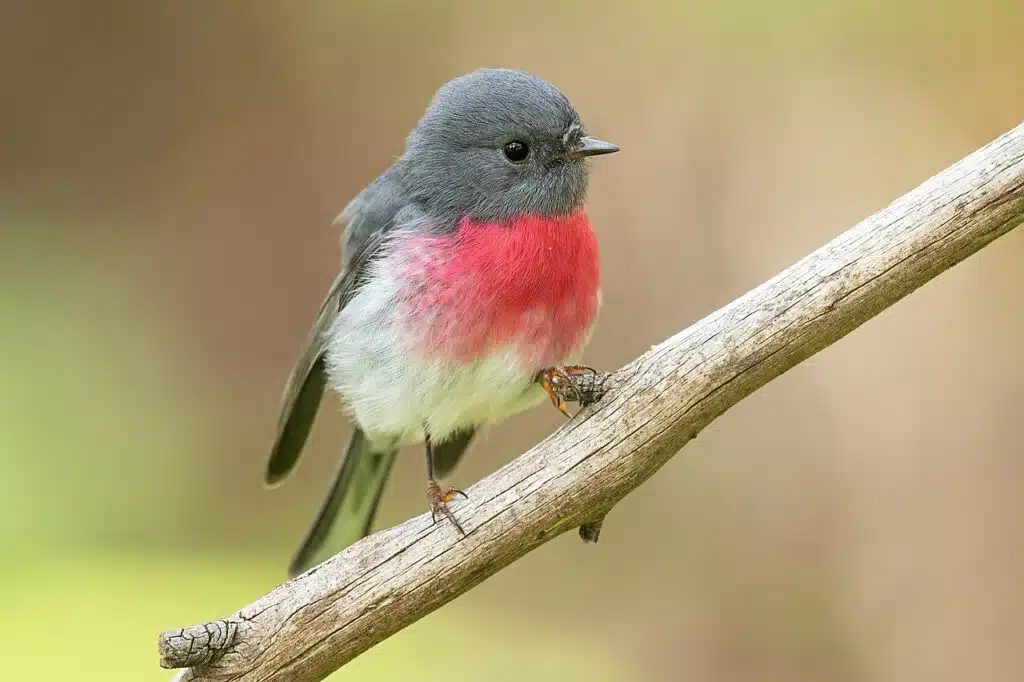
The Rose Robin (Petroica rosea) is a small bird native to Australia. The males have pink breasts and gray bodies with black tails. The belly is white. Females are brown-gray. They have small black beaks and eyes.
They can grow to eleven centimeters in length. Males are easily identified for their pink abdomen and breast. They are common in eastern and southeastern Australia. They are seen in forests, rainforests, and valleys. They have been recorded in Melbourne’s eastern suburbs, Scotchman’s Creek, Dandenong Creek, and Gardiners Creek.
26. Pink Cockatoo
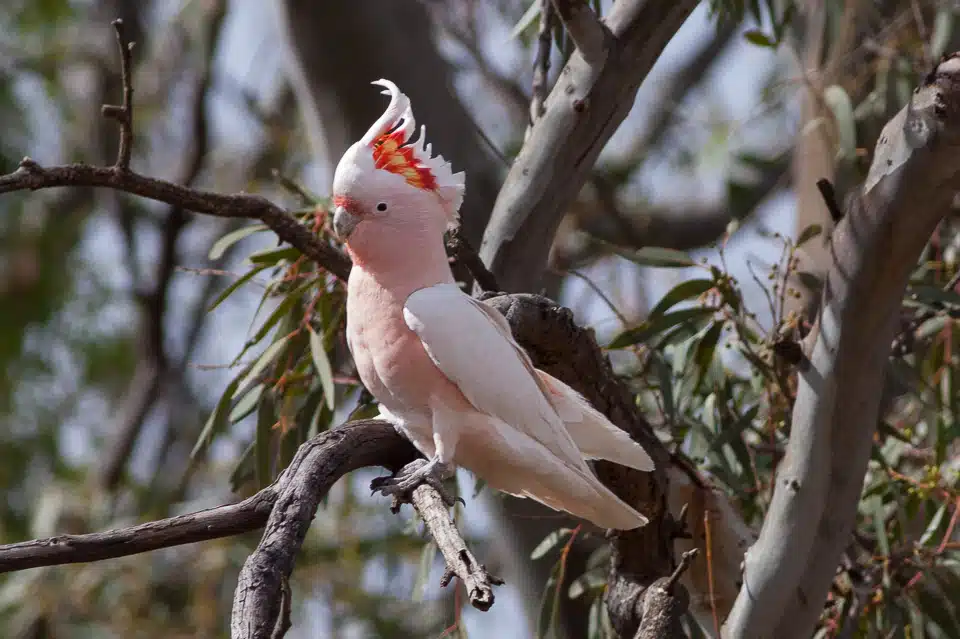
The Pink Cockatoo (Lophochroa leadbeateri) is also known as Major Mitchell’s cockatoo and is a medium-sized bird found in semi-arid inland areas in Australia. It has salmon-pink and white plumage and a bright red and yellow crest. They are considered the most beautiful cockatoo.
The males and females are almost identical, except the males are larger. Females have a broader yellow stripe on their crest and develop a red eye when they reach maturity. Populations of this bird have declined over the years due to man-made changes.
These birds require woodlands, favoring conifers. They do not nest close to each other and do not like partly cleared habitats. As a result, their range is reducing quickly.
27. Pink-headed Warbler
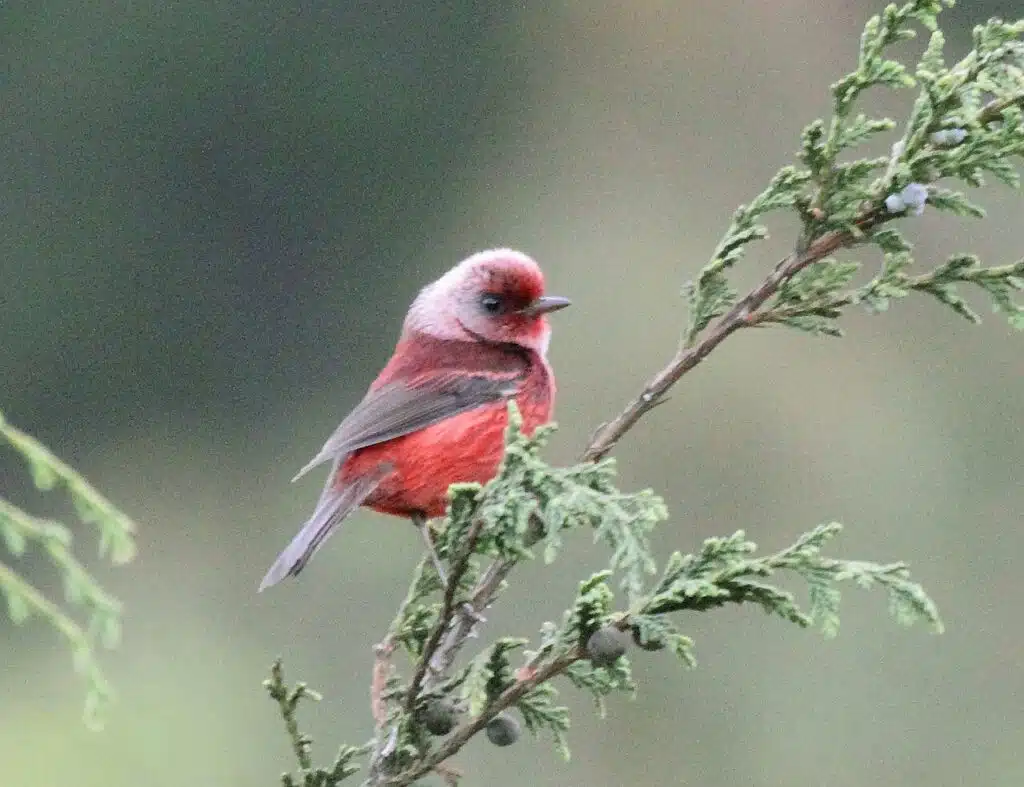
The Pink-headed Warbler (Cardellina versicolor) is a small bird that is found in the southwestern highlands of Guatemala and the central and southeastern highlands of Chiapas in Mexico. The adults are red with silver-pink chests and heads.
They are common in humid and semi-humid pine-oak forests, evergreen forests, and forest edges. They grow to just over thirteen centimeters in length and can weigh up to ten grams. There is very little difference between the sexes, though females tend to be dull in color.
As adults, they have dark red bodies with silver-pink chests and pink bellies. They have red foreheads and dark brown irises. The beak is black and the legs are flesh-colored. As juveniles, they are brown with pale bellies. The plumage is molted and by the late summer, juveniles are almost identical to adults.
These birds have a very metallic call and a weak chip. They send out several short chips. Only the males sing. They can be heard throughout the year in their range. This bird is endemic to Mexico and western Guatemala. They are common in pine-oak, evergreen forests, and forest edges.
They prefer dense forest areas that are undisturbed. They have also moved to El Salvador over the past few years.